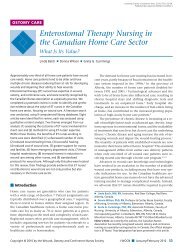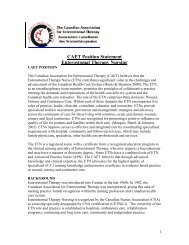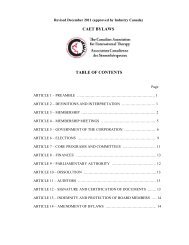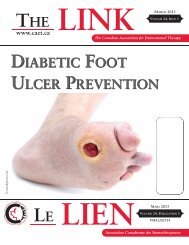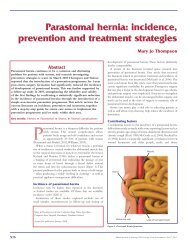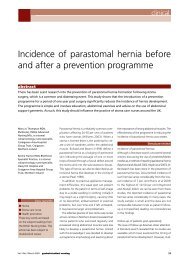Prevention of parastomal hernia: a comparison of results 3 years on
Prevention of parastomal hernia: a comparison of results 3 years on
Prevention of parastomal hernia: a comparison of results 3 years on
You also want an ePaper? Increase the reach of your titles
YUMPU automatically turns print PDFs into web optimized ePapers that Google loves.
Stoma type<br />
Analysis <str<strong>on</strong>g>of</str<strong>on</strong>g> stoma type in year 3 patients<br />
showed that there were more patients with<br />
colostomies (n=51) than with ileostomies (n=43)<br />
or urostomies (n=5).<br />
In the initial study, when the distributi<strong>on</strong> <str<strong>on</strong>g>of</str<strong>on</strong>g><br />
<str<strong>on</strong>g>parastomal</str<strong>on</strong>g> <str<strong>on</strong>g>hernia</str<strong>on</strong>g> was analysed according to<br />
stoma type, the differences were not statistical<br />
significant. This suggested that, irrespective <str<strong>on</strong>g>of</str<strong>on</strong>g> the<br />
type <str<strong>on</strong>g>of</str<strong>on</strong>g> stoma, all stoma patients had an equal risk<br />
<str<strong>on</strong>g>of</str<strong>on</strong>g> developing a <str<strong>on</strong>g>parastomal</str<strong>on</strong>g> <str<strong>on</strong>g>hernia</str<strong>on</strong>g>. However, when<br />
the figures for year 3 in the present study were<br />
analysed, it was found that 13 <str<strong>on</strong>g>of</str<strong>on</strong>g> 17 colostomy<br />
patients had developed a <str<strong>on</strong>g>parastomal</str<strong>on</strong>g> <str<strong>on</strong>g>hernia</str<strong>on</strong>g><br />
compared with <strong>on</strong>ly 4 <str<strong>on</strong>g>of</str<strong>on</strong>g> 17 ileostomy patients;<br />
chi-squared analysis showed these differences<br />
to be statistically significant (P≤0.01), indicating<br />
that there was a correlati<strong>on</strong> between stoma type<br />
and incidence <str<strong>on</strong>g>of</str<strong>on</strong>g> <str<strong>on</strong>g>hernia</str<strong>on</strong>g>ti<strong>on</strong>. Data from the initial<br />
study were therefore revisited and chi-squared<br />
tests were carried out individually for each year.<br />
This time statistically significant differences<br />
were found for each <str<strong>on</strong>g>of</str<strong>on</strong>g> the 3 <str<strong>on</strong>g>years</str<strong>on</strong>g>, reinforcing<br />
the suggesti<strong>on</strong> that patients with colostomies<br />
are more likely to develop a <str<strong>on</strong>g>parastomal</str<strong>on</strong>g> <str<strong>on</strong>g>hernia</str<strong>on</strong>g><br />
than patients with ileostomies and urostomies<br />
(Figure 4). These <str<strong>on</strong>g>results</str<strong>on</strong>g> support those <str<strong>on</strong>g>of</str<strong>on</strong>g> McGrath<br />
et al (2006) who, while reviewing the literature<br />
<strong>on</strong> risk factors for <str<strong>on</strong>g>parastomal</str<strong>on</strong>g> <str<strong>on</strong>g>hernia</str<strong>on</strong>g>ti<strong>on</strong>, found<br />
that the incidence <str<strong>on</strong>g>of</str<strong>on</strong>g> <str<strong>on</strong>g>parastomal</str<strong>on</strong>g> <str<strong>on</strong>g>hernia</str<strong>on</strong>g> varied<br />
with the type <str<strong>on</strong>g>of</str<strong>on</strong>g> stoma formed.<br />
When the distributi<strong>on</strong> <str<strong>on</strong>g>of</str<strong>on</strong>g> <str<strong>on</strong>g>parastomal</str<strong>on</strong>g> <str<strong>on</strong>g>hernia</str<strong>on</strong>g>s in<br />
<str<strong>on</strong>g>years</str<strong>on</strong>g> 1, 2 and 3 was analysed according to age <str<strong>on</strong>g>of</str<strong>on</strong>g><br />
the patients it was found that n<strong>on</strong>e <str<strong>on</strong>g>of</str<strong>on</strong>g> the patients<br />
aged 40 <str<strong>on</strong>g>years</str<strong>on</strong>g> or less developed a <str<strong>on</strong>g>parastomal</str<strong>on</strong>g> <str<strong>on</strong>g>hernia</str<strong>on</strong>g><br />
(Figure 5). A possible reas<strong>on</strong> for this may be that<br />
younger patients show better compliance with the<br />
programme or have more active lifestyles.<br />
The literature could be seen to support this<br />
finding, e.g. Bucknall and Ellis (1984) reported<br />
that age 60+ was a c<strong>on</strong>tributing factor in the<br />
development <str<strong>on</strong>g>of</str<strong>on</strong>g> <str<strong>on</strong>g>parastomal</str<strong>on</strong>g> <str<strong>on</strong>g>hernia</str<strong>on</strong>g>. It was noted<br />
that the modal age group for patients who<br />
developed a <str<strong>on</strong>g>parastomal</str<strong>on</strong>g> <str<strong>on</strong>g>hernia</str<strong>on</strong>g> was 61–80 <str<strong>on</strong>g>years</str<strong>on</strong>g><br />
in year 1 and 41–60 <str<strong>on</strong>g>years</str<strong>on</strong>g> in year 2; however,<br />
in year 3 it changed back to the 61–80 <str<strong>on</strong>g>years</str<strong>on</strong>g>.<br />
When these <str<strong>on</strong>g>results</str<strong>on</strong>g> were tested for significance<br />
using the chi-squared test, a value <str<strong>on</strong>g>of</str<strong>on</strong>g> P≤0.05 was<br />
obtained, indicating that the differences were<br />
statistically significant. On closer examinati<strong>on</strong><br />
<str<strong>on</strong>g>of</str<strong>on</strong>g> the data, it was noted that all <str<strong>on</strong>g>of</str<strong>on</strong>g> the patients<br />
in age group 61–80 who had developed a<br />
<str<strong>on</strong>g>parastomal</str<strong>on</strong>g> <str<strong>on</strong>g>hernia</str<strong>on</strong>g> had a colostomy.<br />
Time <str<strong>on</strong>g>of</str<strong>on</strong>g> development <str<strong>on</strong>g>of</str<strong>on</strong>g> <str<strong>on</strong>g>parastomal</str<strong>on</strong>g> <str<strong>on</strong>g>hernia</str<strong>on</strong>g><br />
The time <str<strong>on</strong>g>of</str<strong>on</strong>g> development <str<strong>on</strong>g>of</str<strong>on</strong>g> <str<strong>on</strong>g>parastomal</str<strong>on</strong>g> <str<strong>on</strong>g>hernia</str<strong>on</strong>g><br />
was examined <strong>on</strong>ly in the prospective arms <str<strong>on</strong>g>of</str<strong>on</strong>g> the<br />
study (<str<strong>on</strong>g>years</str<strong>on</strong>g> 2 and 3). The retrospective arm <str<strong>on</strong>g>of</str<strong>on</strong>g><br />
the study (year 1) was not examined because <str<strong>on</strong>g>of</str<strong>on</strong>g><br />
poor documentati<strong>on</strong> <str<strong>on</strong>g>of</str<strong>on</strong>g> the time <str<strong>on</strong>g>of</str<strong>on</strong>g> development<br />
<str<strong>on</strong>g>of</str<strong>on</strong>g> <str<strong>on</strong>g>parastomal</str<strong>on</strong>g> <str<strong>on</strong>g>hernia</str<strong>on</strong>g>. In year 2, 56% <str<strong>on</strong>g>of</str<strong>on</strong>g> patients<br />
developed a <str<strong>on</strong>g>parastomal</str<strong>on</strong>g> <str<strong>on</strong>g>hernia</str<strong>on</strong>g> within 6 m<strong>on</strong>ths <str<strong>on</strong>g>of</str<strong>on</strong>g><br />
surgery; in year 3 the timing was almost identical<br />
to that in year 2, which again suggests reliability<br />
<str<strong>on</strong>g>of</str<strong>on</strong>g> the <str<strong>on</strong>g>results</str<strong>on</strong>g>. In <str<strong>on</strong>g>years</str<strong>on</strong>g> 2 and 3, 58% <str<strong>on</strong>g>of</str<strong>on</strong>g> patients<br />
developed their <str<strong>on</strong>g>hernia</str<strong>on</strong>g> within 6 m<strong>on</strong>ths <str<strong>on</strong>g>of</str<strong>on</strong>g> surgery,<br />
which again is supported by the literature.<br />
These <str<strong>on</strong>g>results</str<strong>on</strong>g> are comparable to those <str<strong>on</strong>g>of</str<strong>on</strong>g><br />
Bucknall et al (1982), who showed that 57%<br />
<str<strong>on</strong>g>of</str<strong>on</strong>g> abdominal incisi<strong>on</strong>al <str<strong>on</strong>g>hernia</str<strong>on</strong>g>s (n=84) had<br />
developed before 3 m<strong>on</strong>ths postoperatively,<br />
and reinforce the need to endorse the use <str<strong>on</strong>g>of</str<strong>on</strong>g><br />
abdominal exercises and support garments for<br />
clinical<br />
Figure 3. Incidence <str<strong>on</strong>g>of</str<strong>on</strong>g> <str<strong>on</strong>g>parastomal</str<strong>on</strong>g> <str<strong>on</strong>g>hernia</str<strong>on</strong>g> in <str<strong>on</strong>g>years</str<strong>on</strong>g> 1, 2 and 3 (Yes = <str<strong>on</strong>g>parastomal</str<strong>on</strong>g><br />
<str<strong>on</strong>g>hernia</str<strong>on</strong>g> present; No = no <str<strong>on</strong>g>hernia</str<strong>on</strong>g>ti<strong>on</strong>).<br />
Figure 4. Distributi<strong>on</strong> <str<strong>on</strong>g>of</str<strong>on</strong>g> <str<strong>on</strong>g>parastomal</str<strong>on</strong>g> <str<strong>on</strong>g>hernia</str<strong>on</strong>g> according to stoma type in <str<strong>on</strong>g>years</str<strong>on</strong>g> 1, 2 and 3.<br />
vol 5 no 3 April 2007 gastrointestinal nursing 27






